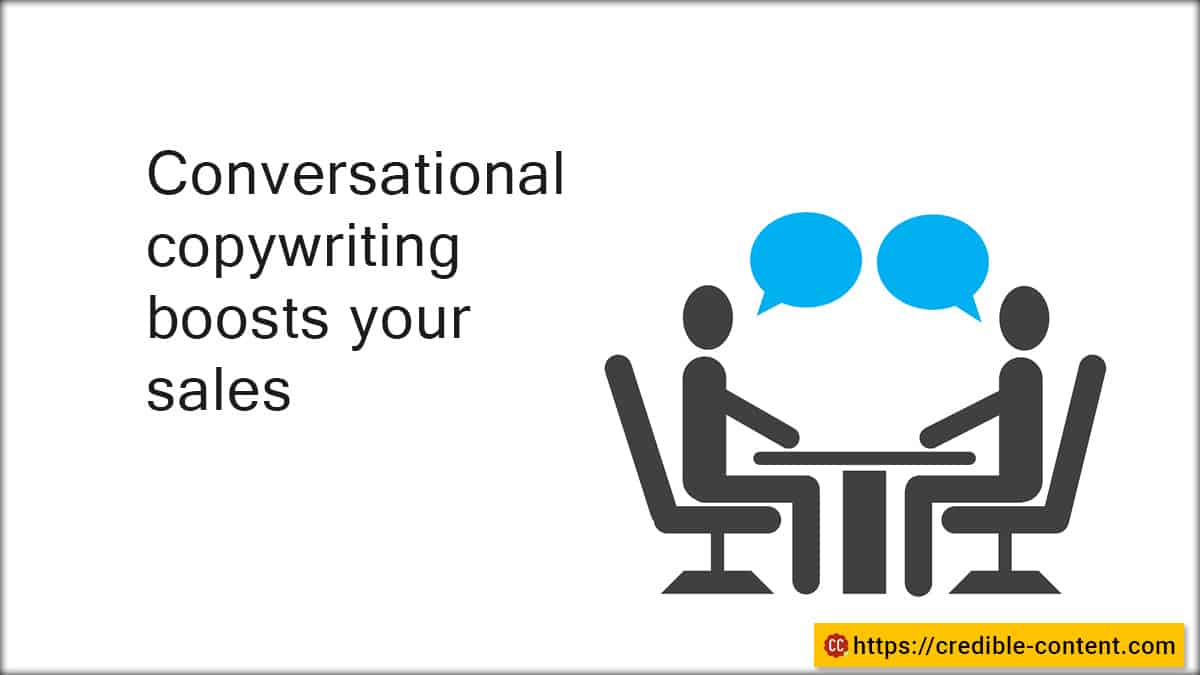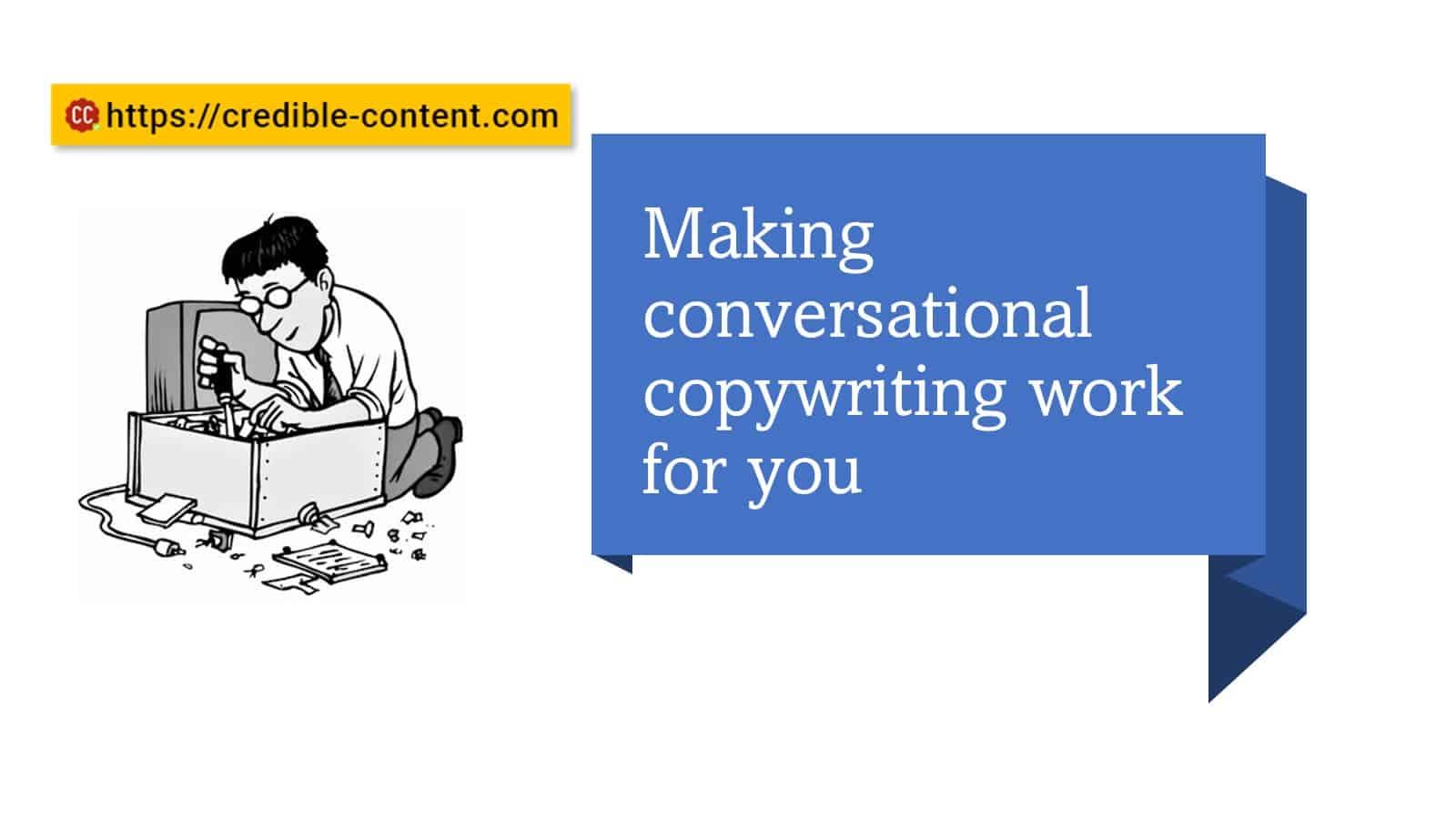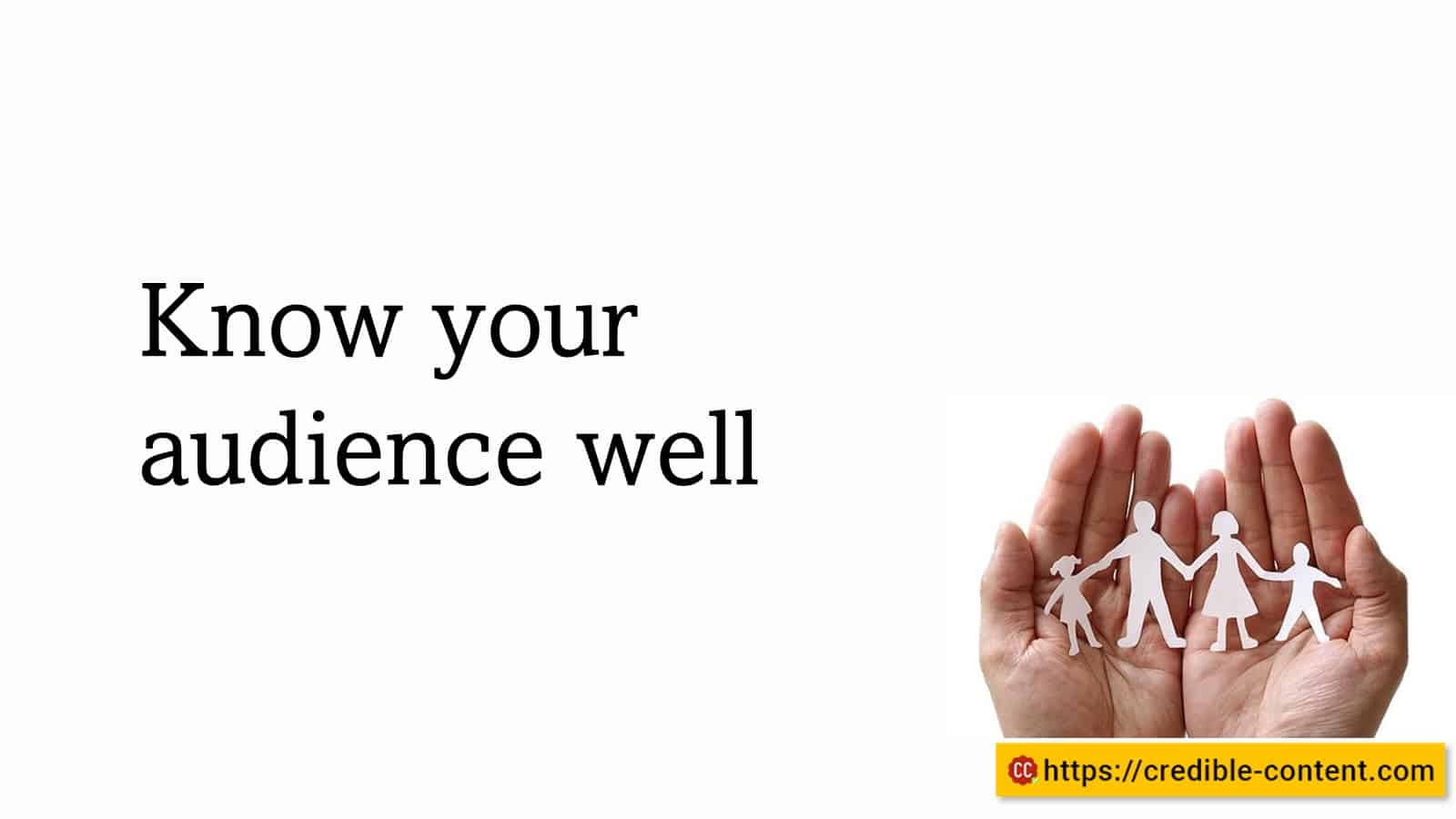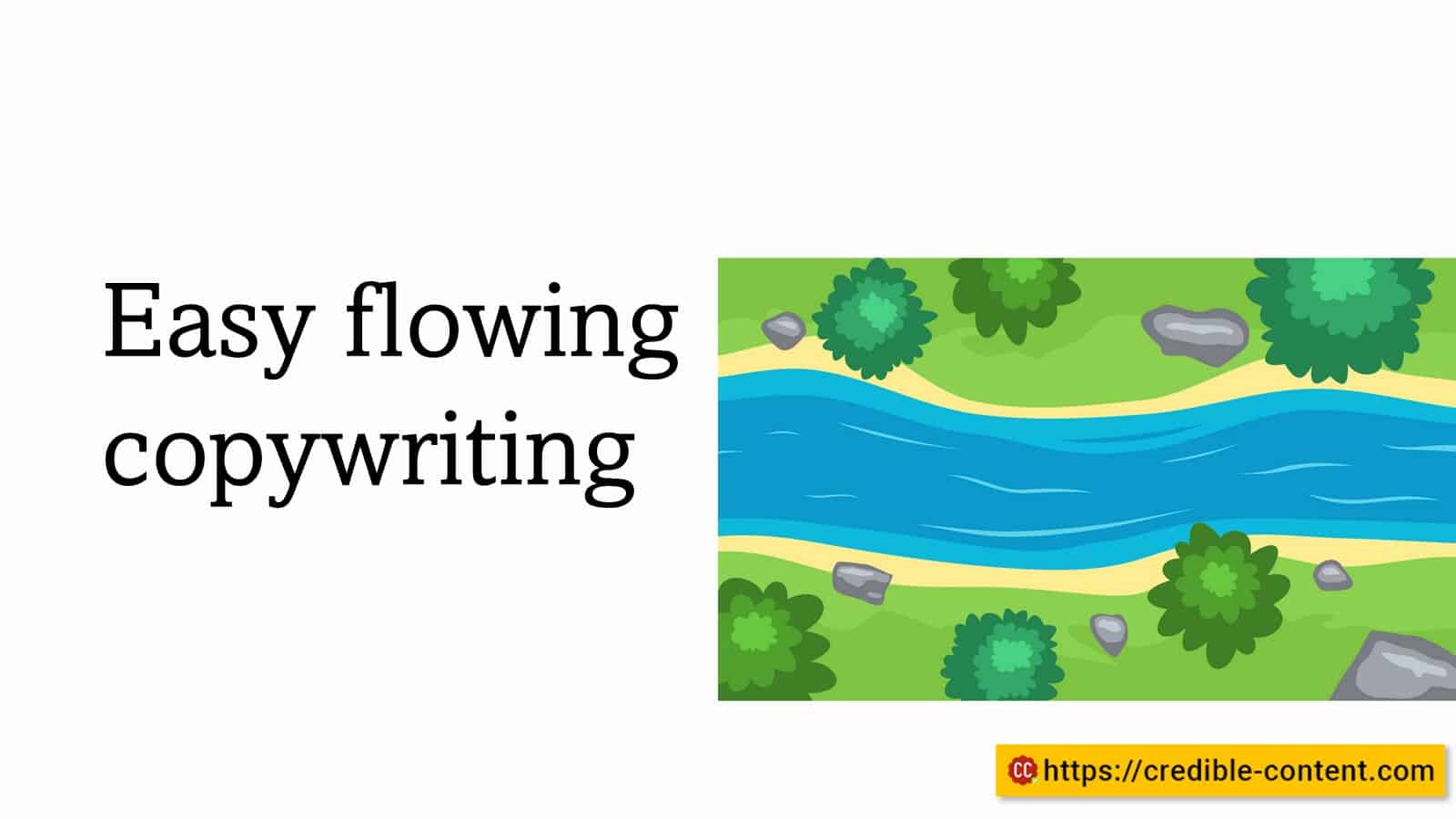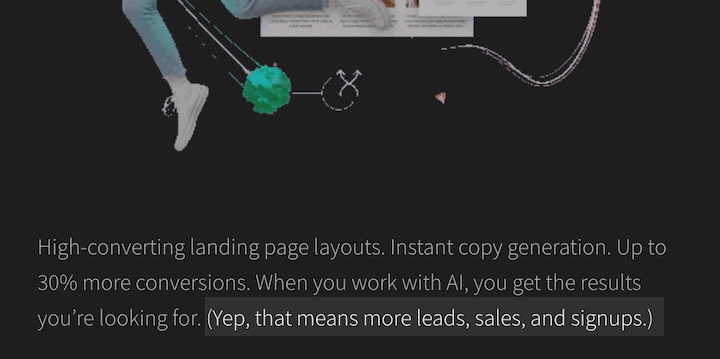When you want to increase your sales through conversational copywriting, it’s all about “talking” to your prospects.
What all you need to do to be a conversational copywriter?
Many confuse conversational copywriting with dumbing down their writing: it is not like that.
You need to write the way your audience speaks.
If they don’t understand your language, your writing falls on deaf ears.
How do you write a conversational copy?
- Understand their needs and desires.
- Make a psychological and emotional connection with them.
- Write in a manner as if they’re sitting in front of you and you’re talking to them.
One thing you need to keep in mind: you don’t converse with a customer or client the way you converse with your friend or sibling.
Why conversational copywriting makes a big difference?
Conversational copy makes you write in the language of your target audience, the speech patterns and words and phrases that they normally use.
When you talk to your prospects in their own language, you come off as a person they can trust, someone they can take seriously.
They are also in a better position – psychologically – to pay attention to you and what you are saying.
Unconsciously, they begin to believe that since your writing seems so easy going and personal, you must know more about the product or service you are explaining.
You can solve their problem.
They find it relatable.
At a deep psychological level, you can make a connection as a conversational copywriter.
How can you make a difference with conversational copywriting?
Be brief
It is easy to digest and understand your copy if it is brief.
When they can easily read and understand your copy, they stay engaged and they read your copy till the end.
Here is an example of a long-winded copy:
Through offering my revolutionary SEO copywriting services that are tailored to your unique needs and perfectly fit your budget, I can help you improve your search engine rankings and attract unique customers and clients to your website, and in the process, help you generate more business.
Instead, you can make it brief in the following manner:
I offer tailored SEO copywriting services. They perfectly fit your needs and budget. You will attract more customers and clients from search engines. You will generate more business.
You may say that I’m writing more sentences, but they are much smaller and easy to read.
A conversational copywriter knows that prospects these days are busy.
There are multiple stimulants vying for their attention.
If you don’t make your sentences easy to read, even when they try to focus and read your copy, they will get exhausted and take their attention somewhere else.
Make a personal connection
Another great attribute of conversational copywriting is that you make a personal connection.
It makes your reader feel as if you are speaking to them one-on-one.
You are not just any other business person hellbent on making a sale.
Being a conversational copywriter, you have the welfare of the prospect in your heart – you should, actually.
For example, if I offer you my SEO copywriting services, of course, I want you to hire me.
It is in my interest that you agree to work with me.
But at the same time, my ultimate desire must be to improve your search engine rankings meaningfully.
Just as I am worried about my business, I should also be worried about your business because the welfare of your business means the welfare of my business.
Hence, instead of constantly trying to sell you, I must tell you how trustworthy SEO copywriting services can genuinely improve your organic search engine rankings and hence, get you more business.
When you focus more on conversational copywriting and less on making sales, you write as if you are concerned about the welfare of your prospects.
It is communicated through your words, phrases, and the way you express yourself.
By showing interest in the others’ welfare, you make a personal connection.
Conversational copywriting can also be about your brand personality
Just because you’re talking about your business doesn’t mean you talk stiffly.
Many customers and clients prefer to do business with a company not because they offer a great utilitarian product or service.
They buy their products and services because these companies make a personal or an emotional connection.
When you make a personal connection, it becomes much more than just a product or a service.
You’re not buying a product, your endorsing the brand.
You are associating your own values with the values of the brand.
Making conversational copywriting work for you
You cannot pretend to converse with your target audience.
The effort must come out to be authentic if you are a trained and experienced conversational copywriter.
Before writing your copy, think of how you can talk to people.
Think of how they talk to each other in the context of your product or service.
How will they talk to you? What words and phrases will they use? What will be their concerns? What will make them more interested in your offer?
Here are a few steps you can take to perfect your conversational copy.
Get familiar with your audience
Unless you know them properly, how are you going to talk to them in their language?
I would like to explain that “talking in their language” doesn’t mean talking in their regional language (although, that will be much more effective).
For example, if my prospect lives in Germany and speaks the Dutch language it doesn’t mean I must speak to him or her in Dutch language.
Yes, it would be ideal if I could speak to them in their own language, but even if I’m writing my copy in English, I should write in a manner they would normally write.
I’m not here to impress them. I’m here to make a personal connection.
How do you know your audience?
Ask the right questions.
Visit social media platforms and blogs in your niche and take note of how people talk to each other, how they interact with each other. Visit online forums.
Gather information about them. In copywriting terms, it is like creating a persona. You may like to ask the following questions:
- Are they in a position to buy your product or service?
- What are their likes and dislikes pertaining to your product or service?
- What words or phrases do they use when they talk about your product or service?
- Do they have favorite blogs, news sources, and online forums when they’re looking for information on your product or service?
- How much experience do they have in their profession, especially related to your product or service?
- What problems are they currently facing and what solutions are they seeking?
- What language do they use to discuss problems related to your product or service.
One thing is very important: it’s not just knowing about how they talk, it’s about how they talk about your product or service.
Compiling this information will help you channelize your copywriting towards a more understandable and relatable format.
Keep your copywriting easy flowing
Avoid a stifled writing style.
I know, this is possible only if you are completely comfortable with your ability to express yourself as a conversational copywriter, but once that is confirmed, there is no need to over think.
Your copy should easily role off the tongue.
It doesn’t mean you need to be careless when writing. You will need to refine. You will need to polish your copy. You will make it sound professional.
This is where your ability to be a conversational copywriter will shine through.
Want to know if your copy is easy flowing?
Read out loud. See how it sounds.
If possible, record it on your phone and then listen to it. Are there too many halts. Does it need some effort to pronounce certain words and phrases? Do you get distracted while listening?
Refine after you have completely written your copy
Write in a flow, preferably in one go, but later, since your copy is going to be used professionally, refine it to your heart’s content.
Writing as you talk doesn’t mean you include all those stutters, pauses, and unfinished thoughts.
They may feel normal as you talk, but in writing, they will appear incoherent and unprofessional.
Main elements of conversational copywriting
Writing as if you’re talking is not as simple as it seems. This way, anyone could become a great copywriter.
The key is, knowing which elements make you a great conversational copywriter. Listed below are a few characteristics you can incorporate into your copy to make it conversational.
Be concise
As mentioned above, you need to be brief when you need to deliver a message convincingly.
As much as possible, use shorter words – 1-2 syllables. Use contractions and abbreviations.
Remember that you don’t need to sound scholarly. You are writing for people who may not be much educated or they may not be used to regularly reading long and convoluted words and expressions.
You don’t need to impress. You need to convince. You don’t want to intimidate your readers. You want to educate and inform them.
Example of copywriting that is not concise:
Our software product will revolutionize the way you handle your internal memos and automate meeting reminders and note taking processes so that your employees can focus on executing their responsibilities rather than managing paperwork and keeping track of their schedule.
By the time the reader reaches the last word of the sentence, they lose the track of what was being communicated.
You can make it concise in this manner:
Manage internal memos well and automate meeting reminders with our software. Let your employees focus on work rather than spending time on paperwork, note taking and scheduling.
It is simple and straightforward. Easier to read. Easier to comprehend.
Get passive about passive voice
In the passive voice, grammatically, the sentence focuses on the verb rather than the subject.
Ideally, in your sentence, the subject must be the focus.
Passive voice takes attention away from your main point.
Passive voice: The website will be audited by our SEO team.
Active voice: Our SEO team will audit your website.
Also, avoid using adverbs and adjectives. They needlessly increase the number of words your readers need to read.
Hence, instead of writing “It is clearly stated on our website” you can write “It is stated on our website.”
Use psychological triggers in your language
Create an image in the reader’s mind. Instead of telling your prospects how hard they have to work in the absence of your software, let them imagine the long hours they need to spend and how they get home late and how they are missing all the fun that they could have had with their kids.
Take for example this copy:
Install our task management app. It works fast. It has a great interface. Create unlimited tasks and subtasks. Very light. Can be used for large project management needs.
Instead, paint a picture in the mind of the reader:
Wouldn’t it be great if you could spend a relaxing evening at home because all your tasks are complete? Want to see happy and productive employees because they can manage their tasks well and increase their productivity? You can finally take a vacation you haven’t been able to take for years. Install our task management app now and make working om large projects a breeze.
Let your readers imagine how wonderful their life will be after buying your product or using your service.
To be an effective conversational copywriter, focus on their needs and desires
Everyone is interested in their own issues. They don’t want to read how great your product or service is unless it does something for them.
Make your readers feel special. Give them an emotional high.
Instead of
This SEO copywriting technique helped me rank #1 for 25 of my keywords.
You can write
This SEO copywriting technique will help you gain #1 rank for your important keywords.
Instead of
We built a mobile app with this no-code AI interface merely in two weeks.
You can write
Build a mobile app merely in two weeks using this no-code AI interface.
Write copy in your unique voice
What has it got to do with conversational copywriting? Doesn’t every experienced copywriter have his or her own unique way of writing?
Recently I wrote on LinkedIn that many clients hire me for my unique copywriting style.
Writing in your own style can help you become a better conversational copywriter because instead of being conscious about how you must sound, you will have a conversation with your readers because of your confidence.
Yes, writing style needs confidence.
When you’re completely sure of your skill, you sound effortless, and when you sound effortless, your writing doesn’t appear stifled.
Can you captivate your audience with conversational copywriting?
Yes, you can.
The ability to hold a conversation through your copy is a crucial skill and it can help you in any industry whether you are a professional copywriter or any other professional wanting to write convincing copy.
There are many entrepreneurs who have never worked with a professional copywriter.
All they do is, they write the copy in a very simple, friendly style their audience can easily understand.
They don’t use fluff. They don’t make big claims. They don’t use flowery language or earth-shattering expressions.
They use simple day-to-day words to talk to their prospects.
When you write simply, in a conversational manner, you easily build trust. You can engage your readers. You can establish better connections that are long lasting.
Some conversational copywriting tips and tricks
Personally I believe that as a as a professional copywriter, conversational style is about your personal style. Nonetheless, there are some tips and tricks that you can follow – some aspects of copywriting that you can use in a template format.
These tips and tricks can help build a framework and save you precious time.
Use conversational expressions that are normally used when you’re talking
Here are some expressions that you can use to make your writing more conversational.
- Having doubts? I get it.
- I understand, it must be horrible.
- Then suddenly it hit me.
- Probably not the best idea, right?
- Frankly, it was a dream come true.
- Let’s rehash.
- You see, normally I wouldn’t do that.
- So, this is what happened…
- Crazy, right?
- Know the real story?
- This is the stuff dreams are made of.
- I couldn’t believe my eyes.
These expressions, and many more like these, can inject a sense of proximity. You normally use these expressions when you are talking to someone.
Use psychological transitions
In psychological transitions during conversational copywriting, mentally, you bring your prospect to a situation where he or she readily agrees with you.
One of such psychological transitions is, making the person say yes to something so that when you make an offer, it is difficult for him or her to say no.
Something like this:
Are you enjoying the weather (assuming it’s a nice weather)? The person will say yes.
Isn’t it always good to be able to help people? The person will say yes.
You can create 2-3 such questions for which the response is bound to be yes, and when the person is in that “yes” mode, you make your offer.
Another psychological transition in copywriting is reciprocity.
When you do someone some good, it is difficult for that person to say no to you.
Hence, provide so much useful information to that person that ultimately when you present him or her with your CTA, he or she wants to reciprocate.
Copywriting is all about conversion and the best way to convert people is through meaningful conversations.
When you converse with them, when you talk to them, you build trust. Through trust, you build emotional and psychological connections.
They are less skeptical if you seem to represent their interests.
But make sure you don’t pretend to represent their interests.
Conversational copywriting must be genuine.
Show real interest in them. Take real interest in them.
Whenever you’re writing, think how your writing can benefit your prospects.

